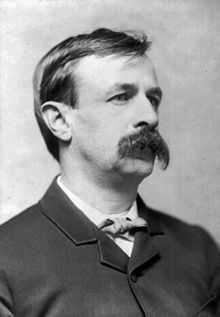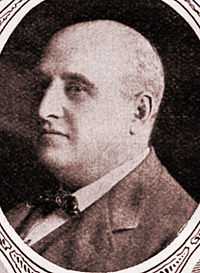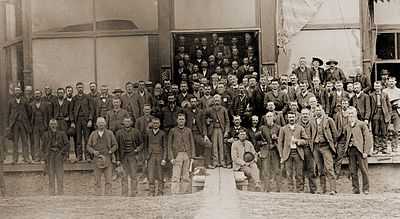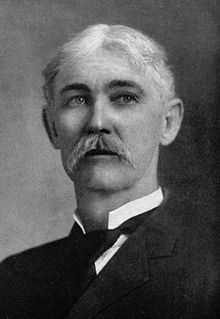Nationalist Clubs

Nationalist Clubs were an organized network of socialist political groups which emerged at the end of the 1880s in the United States of America in an effort to make real the ideas advanced by Edward Bellamy in his utopian novel, Looking Backward. At least 165 Nationalist Clubs were formed by so-called "Bellamyites," who sought to remake economy and society through the nationalization of industry.[1] One of the last issues of "The Nationalist" noted that 'over 500' had been formed.[2] Owing to the growth of the Populist movement and the financial and physical difficulties suffered by the movement's namesake, the Bellamyite Nationalist Clubs began to dissipate in 1892, lost their national magazine in 1894, and vanished from the scene entirely circa 1896.
Organizational history
Background

In 1888, a young Massachusetts writer named Edward Bellamy published a work of utopian fiction entitled Looking Backward, 2000-1887, telling the Rip Van Winkle-like tale of a 19th-century New England capitalist who awoke from a deep slumber to find a completely changed society in the far-distant year of 2000.[3] In Bellamy's tale, a non-violent revolution had transformed the American economy and thereby society; private property had been abolished in favor of state ownership of capital and the elimination of social classes and the ills of society that he thought inevitably followed from them.[3] In the new world of the year 2000, there was no longer war, poverty, crime, prostitution, corruption, money, or taxes.[3] Neither did there exist such occupations seen by Bellamy as of dubious worth to society, such as politicians, lawyers, merchants, or soldiers.[3]
Instead, Bellamy's utopian society of the future was based upon the voluntary employment of all citizens between the ages of 21 and 45, after which time all would retire.[3] Work was simple, aided by machine production, working hours short and vacation time long.[3] The new economic basis of society effectively remade human nature itself in Bellamy's idyllic vision, with greed, maliciousness, untruthfulness, and insanity all relegated to the past.[3]
This vision of American possibilities came as a clarion call to many American intellectuals, and Looking Backward proved to be a massive best-seller of the day. Within a year, the book had sold some 200,000 copies and by the end of the 19th century, it had sold more copies than any other book published in America outside of Uncle Tom's Cabin by Harriet Beecher Stowe.[4] Moreover, a new political movement spontaneously emerged, dedicated to making Bellamy's utopian vision a practical reality — the so-called "Nationalist Movement," based upon the organization of local "Nationalist Clubs."
Origins (1888)
Preparation for the first Nationalist Club had begun early in the summer of 1888 with a letter from Cyrus Field Willard, a labor reporter for the Boston Globe who had been moved by Bellamy's vision of the future. Willard wrote directly to the author, asking for Bellamy's blessings for the establishment of "an association to spread the ideas in your book."[5] Bellamy had responded to Willard's appeal positively, urging him in a July 4 letter:
"Go ahead by all means and do it if you can find anyone to associate with. No doubt eventually the formation of such Nationalist Clubs or associations among our sympathizers all over the country will be a proper measure and it is fitting that Boston should lead off in this movement."[6]
No formal organization immediately followed based upon Willard's efforts, however, and it was not until early September that an entity known as the "Boston Bellamy Club" independently emerged, with Charles E. Bowers and Civil War General Arthur F. Deveraux playing the decisive organizing role.[7] This group issued a public appeal on September 18, 1888, a short document which declared there to be "no higher, grander or more patriotic cause for men to enlist in than one for the elevation of their fellow man" and stated that "Edward Bellamy in his great work, Looking Backward, has pointed out the way by which the elevation of man can be attained."[7]
In October 1888 Willard's small Nationalist circle joined forces with the Boston Bellamy Club, establishing "a permanent organization to further the Nationalization of industry."[8] The first regular meeting of this remade organization, the "Nationalist Club" of Boston, was held on December 1, 1888, attended by 25 interested participants, with Charles E. Bowers elected chairman.[8] A committee of 5 was established to create a plan for a permanent organization, including Boston Herald editorial writer Sylvester Baxter, Willard, Devereux, Bowers, and Christian socialist clergyman W.D.P. Bliss.[8] The third meeting of the Boston Nationalist Club, held on December 15, was attended by Bellamy himself, who predictably received a warm welcome.[8]
Boston club members were overwhelmingly of the middle class and included no small number of Theosophists — believers in spiritualism and reincarnation — a popular philosophical trend of the day.[9] Indeed, fully half of the members of the first Nationalist Club were members of the Theosophical Society, including key leaders Willard and Baxter.[10]
The tone of the initial Nationalist movement was philanthropic, intellectual, and elitist, with the Nationalist Clubs structured not as units of a political party — political action was actually prohibited during the group's earliest days — but rather as chapters of an ethical movement.[11] The Boston Nationalist Club held public lectures and from May 1889 published a monthly magazine called The Nationalist, which attempted to spread Bellamy's ideas to a larger audience through the written word.[9]
The Nationalist was simultaneously the bulletin of the Theosophist-dominated Boston Nationalist Club and the official organ of the entire movement.[12] The first editor was Henry Willard Austin, a graduate of Harvard University and attorney who was also a sometimes poet and Theosophist.[13] The magazine never garnered a huge readership, peaking with a paid circulation of 9,000 subscribers, but it was influential in casting the first phase of the Nationalist movement as an ethical propaganda society dominated by the Boston club.[13]
Expansion (1889–1890)

Even before the launch of its monthly magazine, the Nationalist Club of Boston found its emulators around the country. In New York City the New York Nationalist Club was launched on Sunday, April 7, 1889, in response to a call issued by recent Socialist Labor Party gubernatorial candidate J. Edward Hall.[14] Although Hall proved too ill with tuberculosis to attend, a number of New York political activists immediately became active in the New York Nationalist Club, including SLP journalists Lucien Sanial and Charles Sotheran as well as Columbia University lecturer Daniel DeLeon.[14] A group of about 100 members immediately emerged from the organizational gathering.[14]
In Chicago the city's Nationalist Club was actually the continuation of an earlier organization known as the "Collectivist League," a group established on April 10, 1888, at a meeting attended by 20 people, including prominent New York socialist author Laurence Gronlund.[15] President of the Chicago Club was a future top official of the Social Democratic Party of America, Jesse Cox, who notably delivered a lecture on the principles of state ownership of industry to a crowd of 1200 people gathered under the League's auspices at a Chicago theater.[15] In February 1889 the Collectivist League changed its name to the Nationalist Club of Illinois and adopted a new declaration of principles, constitution, and by-laws modeled after those of the Boston Nationalist Club.[15] By May 1889 membership in the Chicago Nationalist Club stood at about 50 and the group had begun with the publication of its own pamphlets and the sponsorship of public lectures.[15]
A Nationalist Club was launched in Washington, D.C. on January 31, 1889, and in Hartford, Connecticut on February 12, 1889.[16] Other clubs sprouted up, in the words of Cyrus Field Willard, "here and there, as if by magic."[14] By 1891 it was reported that no fewer than 162 Nationalist Clubs were in existence.[17] Other Nationalist Clubs were established abroad, including groups in Canada, England, and New Zealand.[18]
The Bellamyite movement was a particularly potent in the state of California, which was home to 65 local Nationalist Clubs — about 40% of the organization's total — as well as 5 Nationalist periodicals.[18] By way of contrast, the populous Eastern state of New York was home to just 16 Nationalist Clubs — and other states had fewer.[18]
While the social composition of the Nationalist Clubs was generally dominated by urban professionals, including doctors, lawyers, teachers, journalists, and clergymen motivated by the social gospel,[19] at times these groups drew the participation of an altogether different constituency, including active trade unionists affiliated with the Knights of Labor or the American Federation of Labor.[9] Among those participating were high-ranking AF of L functionary P. J. McGuire in Philadelphia and radical activist Burnette G. Haskell in San Francisco.[20]
The various Nationalist Clubs were not centrally directed but instead possessed a certain amount of local autonomy and were linked together loosely through correspondence and co-sponsorship of touring lecturers.[21]
Politicization (1891–1892)

The year 1891 saw the emergence of the People's Party (also known as the "Populists") on a broad basis as well as the eruption of class warfare in the Homestead Steel Strike. These events served to politicize not only the Nationalist Clubs but Bellamy himself and he entered the political fray.[22]
With The Nationalist magazine clearly headed for the financial rocks by the end of 1890, Edward Bellamy launched a new monthly magazine of his own in an effort to transform the Nationalist movement from a contemplative propaganda society into a hard-nosed political movement.[23] This new publication was known as The New Nation, and it first rolled off the presses on January 31, 1891.[23] Bellamy provided the finances for the new venture and sat as publisher and editor.[23] Mason Green, a veteran journalist who was a graduate of Amherst College joined Bellamy as managing editor, with Henry R. Legate, organizer of the politically oriented Second Nationalist Club of Boston, aiding as assistant editor.[24]
For the next three years the Nationalist movement's earlier largely hands-off approach to the dirty grind of daily politics was replaced by dedicated effort to achieve practical results through immediate political action.[25] The logic of the situation made the upstart reform movement around the Nationalist Clubs the natural ally of the upstart movement emerging around the People's Party, and the two organizations intermingled. Nationalist Club members joined their local People's Party organizations en masse while Bellamy attempted to consolidate this alliance by molding his new publication into one of the most important voices of the Populist movement in the Eastern United States.[26]
Bellamy and the active members of the Nationalist Clubs were strongly supportive of provisions of the People's Party platform which called for the nationalization of the nation's railroads and telegraph system.[27] The Nationalist Clubs remained primarily propaganda organizations even after Bellamy's entry into politics in 1891, although local clubs did occasionally nominate candidates after that date, although most commonly the Nationalists worked in tandem with the People's Party and its candidates.[28]
The move of the Nationalist Clubs and their members from propaganda societies to political entities acting in alliance with the People's Party created a situation whereby the organizations fulfilled duplicate functions, to the detriment of the Bellamy organization. In the assessment of one historian:
"By 1892 Populism had sapped the Nationalist movement of any real vigor it still had. The People's Party had a prospect for immediate success entirely lacking in Nationalism. Hundreds of Nationalists joined the Populists, leaving the clubs virtually hollow shells."[29]
Decline (1893–1896)

Bellamy continued to work on behalf of the Nationalist movement through 1894, authoring a document entitled The Programme of the Nationalists which was published in the intellectual journal The Forum in March of that year.[30] In this document, reprinted by the central publishing house of the Nationalist Clubs based in Philadelphia, Bellamy argued that
"Nationalism is economic democracy. It proposes to deliver society from the rule of the rich, and to establish economic equality by the application of the democratic formula to the production and distribution of wealth. It aims to put an end to the present irresponsible control of the economic interests of the country by capitalists pursuing their private ends, and to replace it by responsible public agencies acting for the general welfare.... As political democracy seeks to guarantee men against oppression exercised upon them by political forms, so the economic democracy of Nationalism would guarantee them against the more numerous and grievous oppressions exercised by economic methods."[31]
On February 3, 1894, Bellamy's The New Nation was forced to suspend publication owing to financial difficulties.[32] The publication's top paid circulation in its best year had only reached the 8,000 mark, and even this had proven to be no more than a fond memory by 1894.[33] New periodicals had emerged to pick up the slack, including The Coming Nation, a weekly newspaper published by Julius Augustus Wayland, which proclaimed itself to be an extension of the Bellamyite political tradition.[27] Two years of phantom existence followed, with a handful of pamphlets produced by a Bureau of Nationalist Literature in Philadelphia on behalf of the rapidly waning movement.[34] By 1896 the Bellamyite movement had expired, with all but a small handful of isolated groups vanished forever.[34] A Nationalist Party did run candidates for office in Wisconsin (unsuccessfully) as late as 1896.[35])
With his health failing from the tuberculosis from which he had suffered since age 25, Bellamy turned once again to literary pursuits. In his last years Bellamy managed a sequel to Looking Backward, entitled Equality, which was published just prior to his premature death in 1898.[36] In this final work, Bellamy turned his mind's eye to the question of feminism, dealing with the taboo subject of female reproductive rights in future, post-revolutionary America.[36] Other subjects overlooked in Looking Backward, such as animal rights and wilderness preservation, were dealt with in a similar context.[36]
As such, Equality has been hailed by historian Franklin Rosemont as "one of the most forward-looking works of nineteenth-century radicalism," and was lauded in its own day by anarchist thinker Peter Kropotkin as "much superior" to Looking Backward for having analyzed "all the vices of the capitalistic system."[36]
Criticism
Bellamy claimed he did not write Looking Backward with a view to creating a blueprint for political action. Asked in 1890 to describe the thought process behind creation of the novel, Bellamy emphasized that he had no particular sympathy with the extant socialist movement, but rather sought to write "a literary fantasy, a fairy tale of social felicity."[37] Bellamy continued that he had "no thought of contriving a house which practical men might live in," but rather attempted to create "a cloud place for an ideal humanity" which was "out of reach of the sordid and material world of the present."[37]
Be that as it may, Bellamy's literary vision was the inspiration of the practical politics of the Nationalist Clubs and has drawn ideological criticism from some contemporary commentators. In the view of historian Arthur Lipow, in his book Bellamy consciously ignored positing democratic control in his idealized structure of the future, instead pinning his hopes upon bureaucratic stratification and quasi-military organization of both economics and social relations.[38] The modern military was seen by Bellamy as a prototype of future society in that it motivated organized and devoted activity in the national interest, Lipow argues.[39] With neither material need nor the pursuit of "wanton luxury" to impel action, it was to be this national interest which was seen as the chief motivating factor.[39]
This was, in Lipow's view, a recipe for authoritarianism:
"If the workers and the vast majority were a brutish mass, there could be no question of forming a political movement out of them, nor of giving to them the task of creating a socialist society. The new institutions would not be created and shaped from below but would, of necessity, correspond to the plan laid down in advance by the utopian planner."[40]
As such, Lipow argues that Bellamy's vision was technocratic in nature, based upon the mandates of an expert elite rather than individual liberty and freely-decided action.[41]
An early Marxist critique of Bellamyism was supplied by Morris Hillquit, a historian of American socialism and leader in the Socialist Party of America, who noted in 1903:
"Bellamy was not familiar with the modern socialist philosophy when he wrote his book. His views and theories were the result of his own observations and reasoning, and, like all other utopians, he evolved a complete social scheme hinging mainly on one fixed idea. In his case it was the idea 'of an industrial army for maintaining the community, precisely as the duty of protecting it is entrusted to a military army'..."
"The historical development of society and the theory of the class struggle, which play so great a part in the philosophy of modern socialism, have no place in Bellamy's system. With him it is all a question of expediency; he is not an exponent of the laws of social development, but a social inventor."[17]
See also
Footnotes
- ↑ F. Rosemont 'Bellamy's Radicalism Reclaimed' in D. Patai (ed.), "Looking Backward, 1988-1888", Amherst MA: The University of Massachusetts Press, 1988, pg. 201.
- ↑ "The Nationalist" 3.2 (Sep. 1890), pg.114.
- ↑ 3.0 3.1 3.2 3.3 3.4 3.5 3.6 Franklin Rosemont, "Edward Bellamy (1850–98)," in Mari Jo Buhle, Paul Buhle, and Dan Georgakas (eds.), Encyclopedia of the American Left. First Edition. New York: Garland Publishing, 1990; pg. 80.
- ↑ Arthur E. Morgan, Edward Bellamy. New York: Columbia University Press, 1944; pp. 148, 252.
- ↑ Cyrus Field Willard, "The Nationalist Club of Boston (A Chapter of History)," The Nationalist, vol. 1, no. 1 (May 1889), pg. 16.
- ↑ Willard, "The Nationalist Club of Boston (A Chapter of History)," pg. 17.
- ↑ 7.0 7.1 Willard, "The Nationalist Club of Boston (A Chapter of History)," pg. 18.
- ↑ 8.0 8.1 8.2 8.3 Willard, "The Nationalist Club of Boston (A Chapter of History)," pg. 19.
- ↑ 9.0 9.1 9.2 Rosemont, "Edward Bellamy (1850–1898)," pg. 81.
- ↑ Arthur Lipow, Authoritarian Socialism in America: Edward Bellamy and the Nationalist Movement. Berkeley, CA: University of California Press, 1982; pg. 226.
- ↑ Lipow, Authoritarian Socialism in America, pg. 224.
- ↑ Frederic C. Jaher, "Nationalist: Boston, 1889-1891," in Joseph R. Conlin (ed.), The American Radical Press, 1880-1960: Volume 1. Westport, CT: Greenwood Press, 1974; pg. 34.
- ↑ 13.0 13.1 Jaher, "Nationalist: Boston, 1889-1891," pp.34-35.
- ↑ 14.0 14.1 14.2 14.3 "News of the Movement," The Nationalist (Boston), vol. 1, no. 1 (May 1889), pg. 23.
- ↑ 15.0 15.1 15.2 15.3 "News of the Movement," The Nationalist (Boston), vol. 1, no. 1 (May 1889), pp. 25-26.
- ↑ "News of the Movement," The Nationalist (Boston), vol. 1, no. 1 (May 1889), pg. 24.
- ↑ 17.0 17.1 Morris Hillquit, History of Socialism in the United States. Fifth Revised and Enlarged Edition. New York: Funk and Wagnalls, 1910; pg. 289.
- ↑ 18.0 18.1 18.2 Howard Quint, The Forging of American Socialism: Origins of the Modern Movement: The Impact of Socialism on American Thought and Action, 1886-1901. Columbia, SC: University of South Carolina Press, 1953; pg. 82.
- ↑ Arthur Lipow, Authoritarian Socialism in America: Edward Bellamy and the Nationalist Movement. Berkeley, CA: University of California Press, 1982; pg. 131.
- ↑ Quint, The Forging of American Socialism, pp. 84-85.
- ↑ Philip S. Foner, History of the Labor Movement in the United States: Volume 2: From the Founding of the AF of L to the Emergence of American Imperialism. New York: International Publishers, 1955; pg. 44.
- ↑ Lipow, Authoritarian Socialism in America, pg. 223.
- ↑ 23.0 23.1 23.2 Frederic C. Jaher, "New Nation: Boston, 1891-1894," in Joseph R. Conlin (ed.), The American Radical Press, 1880-1960. Westport, CT: Greenwood Press, 1974; pg. 36.
- ↑ Jaher, "New Nation: Boston, 1891-1894," pp. 36-37.
- ↑ Lipow, Authoritarian Socialism in America, pg. 30.
- ↑ Lipow, Authoritarian Socialism in America, pp. 30-31.
- ↑ 27.0 27.1 Lipow, Authoritarian Socialism in America, pg. 31.
- ↑ Hillquit, History of Socialism in the United States, pg. 290.
- ↑ Quint, The Forging of American Socialism, pg. 101.
- ↑ See: Edward Bellamy, The Programme of the Nationalists. Philadelphia: Bureau of Nationalist LIterature, 1894.
- ↑ Bellamy, The Programme of the Nationalists, pg. 6.
- ↑ Quint, The Forging of American Socialism, pp. 101-102.
- ↑ Jaher, "New Nation: Boston, 1891-1894," pg. 38.
- ↑ 34.0 34.1 Quint, The Forging of American Socialism, pg. 102.
- ↑ Casson, Henry, ed. The blue book of the state of Wisconsin 1897 Madison, 1897; pp. 656, 657, 663
- ↑ 36.0 36.1 36.2 36.3 Rosemont, "Edward Bellamy (1850–1898)," pg. 82.
- ↑ 37.0 37.1 Edward Bellamy, "Why I Wrote Looking Backward," The Nationalist, vol. 2 (1890), pg. 199.
- ↑ Lipow, Authoritarian Socialism and America, pg. 84.
- ↑ 39.0 39.1 Lipow, Authoritarian Socialism and America, pg. 85.
- ↑ Lipow, Authoritarian Socialism and America, pg. 86.
- ↑ Lipow, Authoritarian Socialism and America, pp. 89-90.
Publications
Official magazines
- The Nationalist (1889–1891)
- The New Nation (1891–1894)
- Vol. 1 (1891) | Vol. 2 (1892) | Vol. 3 (1893) | Vol. 4 (1894)
Books by Edward Bellamy
- Looking Backward, 2000-1887. Boston: Houghton, Mifflin Co., 1889.
- Equality. New York: D. Appleton & Co., 1898.
Other magazines and pamphlets
- Looking Forward, vol. 1, no. 2 (September 1889), National City, California.
- Principles and Purposes of Nationalism: Edward Bellamy's Address at Tremont Temple, Boston, on the Nationalist Club's First Anniversary, December 19, 1889. Philadelphia: Bureau of Nationalist Literature, n.d.
- Edward Bellamy, The Programme of the Nationalists. Philadelphia: Bureau of Nationalist Literature, 1894. —First published in The Forum, March 1894.
Anti-Nationalist publications
- George A. Sanders, Reality; or, Law and Order vs. Anarchy and Socialism: A Reply to Edward Bellamy's Looking backward and Equality. Cleveland: Burrows Brothers, 1898.
Further reading
- Sylvia E. Bowman, Edward Bellamy Abroad: An American Propher's Influence. New York: Twayne Publishers, 1962.
- Sylvia E. Bowman, The Year 2000: A Critical Biography Of Edward Bellamy. New York: Bookman Associates, 1958.
- Laurence Gronlund, "Nationalism," The Arena, vol. 1, whole no. 2 (January 1890), pp. 153-165.
- James J. Kopp, "Looking Backward at Edward Bellamy's Influence in Oregon, 1888-1936," Oregon Historical Quarterly, vol. 104, no. 1 (Spring 2003).
- Everett W. MacNair, Edward Bellamy and the Nationalist Movement, 1889 to 1894: A Research Study of Edward Bellamy's Work as a Social Reformer. Milwaukee, WI: Fitzgerald Co., 1957.
- Daphne Patai (ed.), Looking Backward, 1988-1888: Essays on Edward Bellamy. Amherst, MA: University of Massachusetts Press, 1988.
- Howard Quint, The Bellamy Nationalist Movement: 1888-1894. Ph.D. dissertation. Stanford University, 1942.
- John Thomas, Alternative America: Henry George, Edward Bellamy, Henry Demarest Lloyd and the Adversary Tradition. Cambridge, MA: Harvard University Press, 1983.
- Richard Toby Widdicombe, Edward Bellamy: An Annotated Bibliography of Secondary Criticism. New York: Garland Publishing, 1988.
- William Frank Zornow, "Bellamy Nationalism in Ohio, 1891 to 1896," Ohio State Archaeological and Historical Quarterly, v. 58, no. 2 (1949).